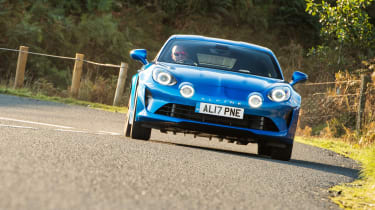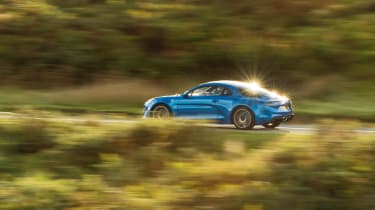Alpine A110 – engine, gearbox and technical highlights
Four-cylinder unit is sweet-revving and eager, and the twin-clutch transmission is quick to shift
The A110 is powered by a 1.8-litre four-cylinder engine with a single turbocharger and direct injection. It’s the same unit that’s used in the Mégane RS and is none the worse for it, producing 249bhp in base spec or a full 296bhp in the GT, S and R. Torque is limited more on account of the transmission, which is 236lb ft for the base car and 251lb ft for the others.
If these figures sound a little bit feeble, it’s worth remembering the relative lack of mass they have to motivate – these are surprisingly rapid little cars, and show off some pretty impressive numbers on their digital driver’s displays.
An added bonus comes despite the powertrain’s relatively humble origin, as the Alpine’s in-line four is a more charismatic and responsive companion than the Porsche’s flat-four. It’s a zingy little unit, responding crisply and quickly to the throttle, its rasping exhaust note egging you on. Ramping up the driver modes (there’s Normal, Sport and Track) adds some extra fruitiness to the soundtrack, with the pops and crackles on the overrun being particularly entertaining and the overall sound a mix of rasping induction noise and growling exhaust.
The seven-speed gearbox is a willing and capable sidekick, although it’s not quite as impressive as the engine itself. There’s nothing intrinsically wrong with it (it shifts swiftly and smoothly enough), it’s simply that the twin-clutch unit isn’t as incisive as you’d want in a sports car. Quick getaways are achieved by slipping the clutches, while there’s a similar feeling on fast changes, giving the impression that performance is being fractionally sapped. Still, you get a nice blip on downchanges, while it’s relatively painless when left to its own devices. It’s responsive enough in Sport mode too, encouraging you to drive in this mode more often than not.
More reviews
Underpinning the Alpine is a light and strong aluminium structure, while the same material is used for the body panels, all of which helps the Alpine tip the scales at 1103kg in base form. The car’s pure ethos is reflected in its suspension, which features unequal-length wishbones front and rear, coil springs and passive dampers – Alpine’s engineers wanted to avoid complexity and so adaptive items were dismissed.
Even the A110 R's adjustable suspension is tweaked manually, with ZF dampers that feature 20 clicks of combined bump/rebound adjustment. The R also features Eibach springs which are 10 per cent stiffer and new bump stops, along with stiffer anti-roll bars. The setup sits 10mm lower than that of the A110 S, but can be dropped by an additional 10mm for the track. The changes combine with a lower 1082kg kerb weight, more powerful aero and sticky Michelin Cup 2 tyres to make the R by far the most capable of the four A110 variants.
Weight distribution is, according to Alpine, 44 per cent to the front and 56 per cent to the rear, while weightsaving has even extended to the rear calipers including an integrated handbrake unit. An upgraded Brembo system is available as an option on the base A110 model, and standard on the GT, S and R versions.






